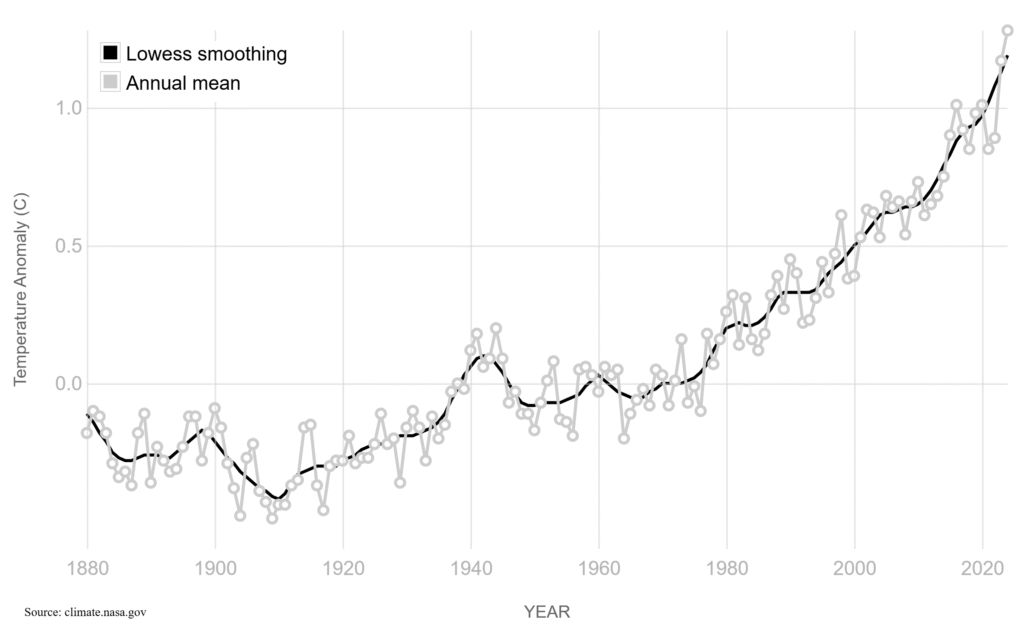Before even starting to discuss about the basics of climate change, you must know that Earth’s climate has never been static (since its formation). However, present-day climate change is different in two important ways:
- The first is that modern climate change is due to human activities.
- The second important aspect is that the change is happening so fast and rapidly that the potential impacts are bound to be huge, enormous, and unparalleled.

Lets’ talk about the history of mankind, if you look at the human activities from past 200 years or so… the human activities are responsible for the present-day climate change, and it has been confirmed that human activities are estimated to have caused approximately 1.6 degrees Centigrade of global warming above pre-industrial levels as of 2024–2025 (IPCC AR6 Synthesis Report 2023/2025; NASA 2025), you know, that’s when industrial revolution started and we started using fossil fuels for the development. So the global warming is now have already reached or temporarily exceeded 1.5 degrees Centigrade as it’s already mid-2020s, with a realistic risk of approaching 2.0 degrees by the 2030s if emissions are not reduced (IPCC Special Report on 1.5°C 2018; WMO 2024; BISI 2025). If current patterns of energy production and use continue, this definitely will be alarming for humanity.

Ocean warming is significant; for instance, ocean bodies account for more than 90% of the excess energy accumulated by the planet between 1971 and 2024 (IPCC AR6 2021, NOAA 2025). In fact, since the beginning of the Industrial Revolution the oceans are sucking up the carbon dioxide like anything, which has led to even more ocean acidification. If you look at the pH value, the global surface ocean pH has dropped from about 8.2 to below 8.1, which is a 30–40% increase in acidity (European Environment Agency 2024, IPCC SROCC 2019). Now this stats will help you to imagine the serious impact on the ocean and the organisms living in ocean ecosystems.

Ok! But what about ice masses? Majorly it’s Greenland and Antarctica. They have started losing mass, meaning tons of ice, due to climate change. As of the latest studies, Greenland has been losing ice at an average rate of 169 ± 9 gigatons per year (1992–2020), while Antarctica’s net ice loss is about 133 gigatons per year, with significant acceleration in recent decades (IMBIE study, 2023; ESA 2023). Similarly, the glaciers present in the terrestrial regions, including the Himalayan glaciers, have shrunk by roughly 40% in area over the past 400–700 years and are melting faster than before (PIB 2022; Welthungerhilfe 2018). Probably the most important symptom of climate change.
Over the period 1901 to 2010, the global mean sea level rose by about 0.19 meters (19 cm); by 2024, the total rise since 1901 is now close to 0.23 meters (23 cm) (IPCC AR5 2014, Copernicus 2023). This is very significant and is related to changing dynamics in the cryosphere.

A visible symptom of climate change is extreme events—extreme climatic events such as heatwaves and heavy precipitation have become more frequent and intense in the near past because of climate change, particularly anthropogenic climate change (IPCC AR6 WG1: Ch. 11, 2021).
When I talk about anthropogenic climate change, we call it modern climate change, driven by Human Action and economic activities, particularly since the Industrial Revolution. Most economic activities have been driven by fossil fuel use and energy consumption, and because of these two reasons, modern climate change is advancing rapidly (IPCC AR6 Synthesis Report 2023). The potential impacts are enormous, and proactive measures are urgently needed to contain the increase in temperature.

Anthropogenic greenhouse gas emissions have increased rapidly; annual greenhouse gas emissions were about 53 gigatons of carbon dioxide equivalent in 2025 (Climate TRACE 2025, UN 2024). From 1750 to 2023, cumulative anthropogenic carbon dioxide emissions are estimated at around 2,400 gigatons of CO₂ (IPCC AR6 Synthesis 2023; Climate Analytics FAQ 2025). Of this total, about 30% has been absorbed by the ocean, around 25% by land ecosystems, and about 45% remains in the atmosphere (IPCC AR6, Synthesis 2023). These proportions highlight the challenge of carbon sequestration and the need for practical mitigation measures.